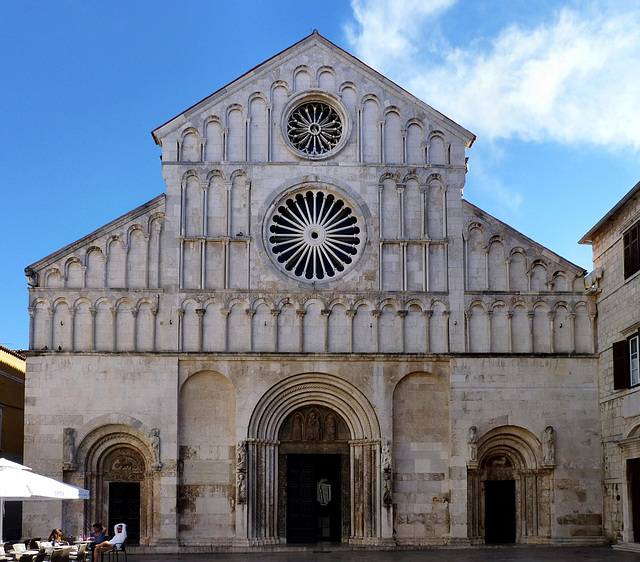Zadar - St. Donatus
Zadar - St. Donatus
Conception Convent (franciscan).
Zadar - St. Donatus
Church of Holy Mary.
Church of Magdalene.
Zadar - St. Lawrence
Posedarje - Sv. Duha
Parish Church.
Church of Our Lady of Passo.
Chapel of Our Lady of Nazareth.
Pridrazi - Sv. Martina
Šibenik - Cathedral of St. James
Šibenik - Cathedral of St. James
Saint Bartholomew Church.
Šibenik - Cathedral of St. James
Šibenik - Cathedral of St. James
Trogir - Cathedral of St. Lawrence
Trogir - Cathedral of St. Lawrence
Trogir - Cathedral of St. Lawrence
Split - Cathedral of Saint Domnius
Split - Cathedral of Saint Domnius
Ort der Stille
Nin - Holy Cross
Nin - Holy Cross
Chapel of calvary steps.
Chapel of calvary steps.
Silanus - Santa Sabina
Ajuda Chapel.
Church of Lord Jesus of Mercy.
Silanus - Santa Sabina
Kirche St. Coloman. ©UdoSm
Kirche St. Coloman. ©UdoSm
Ottana - San Nicola
Seit 400 Jahren Bauruine - One of the oldest unfin…
Saint Francis Church.
Ottana - San Nicola
Ottana - San Nicola
Villaputzu - San Nicola di Quirra
Church of Holy Mary of Alcáçova.
Villaspeciosa - San Platano
Saint Martin Church.
Church of Our Lady in Pain.
Villaspeciosa - San Platano
Villaspeciosa - San Platano
Location
See also...
Keywords
Authorizations, license
-
Visible by: Everyone -
All rights reserved
-
154 visits
Zadar - Cathedral of St. Anastasia


Zadar has a very long history - and after the Romans had left, Ostrogoths, Huns, Avars and Slavs had been here. It was part of the Byzantine Empire upto the early 9th century, when the Franks held it, but returned it to Byzantium after the Treaty of Aachen in 812.
In 1069 Zadar was under the rule of Croatian King Petar Krešimir IV. but already 1102 whole Dalmatia became Hungarian. Since the 12th century Zadar was a rival to Venice. The Venetians and the Crusaders conquered the town after a siege in 1202. Zadar changed hands a couple of times, but in 1409 Ladislaus of Naples, titular King of Hungary (and husband of Mary of Lusignan) sold Dalmatia to Venice for 100.000 ducats.
During the Croatian War of Independence in the 1990s Zadar was under siege for about 2 years and shelled sporadically, what created a lot of damage. Attacks on the city continued until the end of the war in 1995.
-
The Cathedral of St. Anastasia ("Katedrala sv. Stošije") is the seat of the archdiocese of Zadar, that existed already, when the first Bishop Felix attended the Council in Aquileia in 381.
That is, where the current cathedral roots on. Most important bishop was Donatus, who received the ashes of Saint Anastasia from Byzantine Emperor Nikephoros I in the beginning of the 9th century. The ashes are still kept here.
During the siege of Zadar by the Venetians and Crusaders in 1202, the cathedral was heavily damaged. For the entire 13th century the building was under repair. It was reconsecrated in 1285, but was not completed before 1234, what explains the Gothic style of the rose window.
In 1069 Zadar was under the rule of Croatian King Petar Krešimir IV. but already 1102 whole Dalmatia became Hungarian. Since the 12th century Zadar was a rival to Venice. The Venetians and the Crusaders conquered the town after a siege in 1202. Zadar changed hands a couple of times, but in 1409 Ladislaus of Naples, titular King of Hungary (and husband of Mary of Lusignan) sold Dalmatia to Venice for 100.000 ducats.
During the Croatian War of Independence in the 1990s Zadar was under siege for about 2 years and shelled sporadically, what created a lot of damage. Attacks on the city continued until the end of the war in 1995.
-
The Cathedral of St. Anastasia ("Katedrala sv. Stošije") is the seat of the archdiocese of Zadar, that existed already, when the first Bishop Felix attended the Council in Aquileia in 381.
That is, where the current cathedral roots on. Most important bishop was Donatus, who received the ashes of Saint Anastasia from Byzantine Emperor Nikephoros I in the beginning of the 9th century. The ashes are still kept here.
During the siege of Zadar by the Venetians and Crusaders in 1202, the cathedral was heavily damaged. For the entire 13th century the building was under repair. It was reconsecrated in 1285, but was not completed before 1234, what explains the Gothic style of the rose window.
, homaris, have particularly liked this photo
- Keyboard shortcuts:
Jump to top
RSS feed- Latest comments - Subscribe to the comment feeds of this photo
- ipernity © 2007-2024
- Help & Contact
|
Club news
|
About ipernity
|
History |
ipernity Club & Prices |
Guide of good conduct
Donate | Group guidelines | Privacy policy | Terms of use | Statutes | In memoria -
Facebook
Twitter

Sign-in to write a comment.